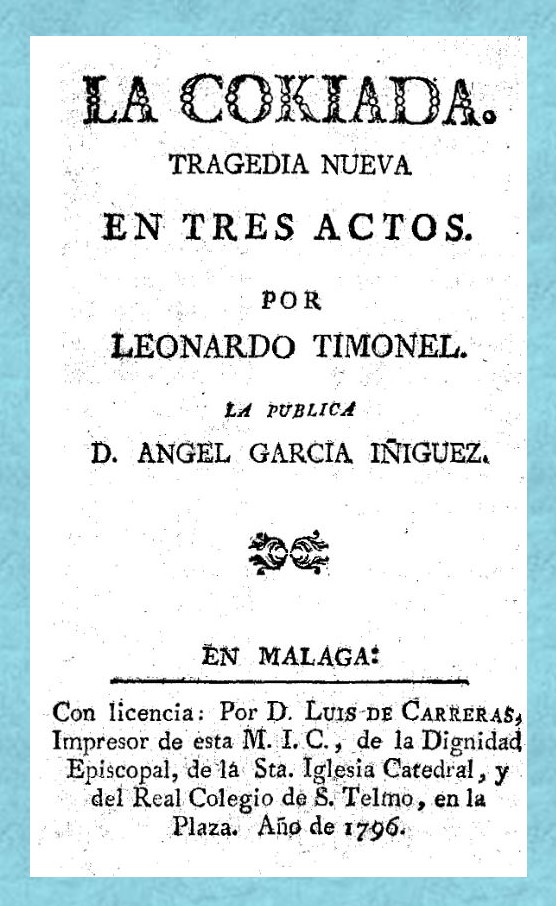The discoveries and death of Captain Cook caused a sensation throughout the Europe. Indicative of the magnitude of his fame, the first theatrical work to celebrate his life was produced not in England, but in France. Drawing on the accounts of his voyages, an opera and ballets were created in Europe to give audiences a glimpse of Cook’s travels in the new lands.
These creative works drew on the detailed descriptions and illustrations of dancing in Tahiti, where it was was a feature of everyday life. This was an aspect of the adventures in the South Seas which was readily adaptable for the stage.
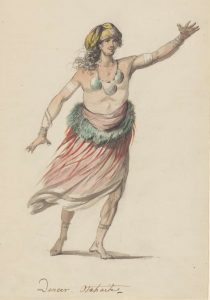
The Tahitians’ love of dancing inspired the creation of ballets in England, France, Italy, Germany, and Spain. This costume was designed by Phillipe Loutherbourg for Omai (1785).
National Library of Australia.
Cook’s journal inspired the first play, Zorai, ou Les Insulaires de la Nouvelle Zelande, which was produced in 1782 by Jean Etienne Francois de Marignie. After only one performance on October 5 it was banned by King Louis XVI on political grounds, and it’s publication was forbidden. A large and enthusiastic audience, including the Queen, had viewed the production, however, it’s blatant support of the monarchy (in France and Britian) was considered inappropriate, given the political climate at the time, and it was decided not to allow further performances.
In autumn 1784, the Italian choreographer Antonio Muzzarelli staged the first ballet d’action portraying Cook in the South Seas. His pantomimic ballet Gl’inglesi in Othaiti (The English in Tahiti) was performed in Lucca, Tuscany and greeted with “universal applause”. Both Antonio and his wife, the prima ballerina, Antonia Vulcani performed in the ballet which was greeted with dazzling reviews. It was divided into three scenes: the first on a beach on the island, the second inside the huts of the villagers, and the third back on the beach where, in the concluding scene, the islanders and Englishmen joined together in a cheerful and lively dance.
As with all the theatrical works depicting Cook, the story had little historical accuracy. The Italian version featured a love affair between the Captain and a Tahitian, something that certainly had not occurred, for although many of his officers and most of his men took lovers on the islands, Cook remained true to his wife Elizabeth, and avoided intimate relations during his travels. It was the scenery, costumes, music and dances that presented a degree of authenticity and contributed enormously to the appeal of the productions. No illustrations of the European performances have been found, however, Phillipe Loutherbourg’s designs for the English productions demonstrate the efforts undertaken to accurately recreate the costumes.
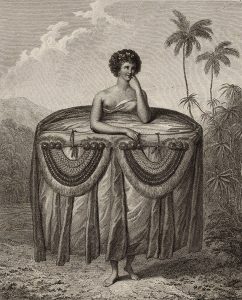
‘A young woman of Otaheite bringing a present’. An illustration based on sketch by artist John Webber, who travelled on Captain James Cook’s third voyage (1776-80). Image: John Webber © Public domain
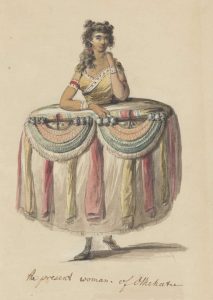
Costume by Loutherbourg for the pantomime Omai. Great care was taken in accurate portrayal.
National Library of Australia
The following year the ballet was adapted as the opera Cook o sia Gl’Inglesi in Otahiti by Umilissimo Vassallo, the director of the Teatro del Fondo di Separazione in Naples. Vassallo wrote in the preface that he considered Italian opera had been too preoccupied with stories from classical antiquity and advocated instead, turning their attention to the exciting new discoveries in the Pacific.
More productions of the ballet, now renamed Il Capitano Cook all’isola degli Ottaiti, were staged throughout Italy over the next few years:
Venice for the carnival of 1786
Verona for the carnival of 1788
Parma for the carnival; la Scala, Milan, and Florence in autumn, 1789
Rome, performances in 1790
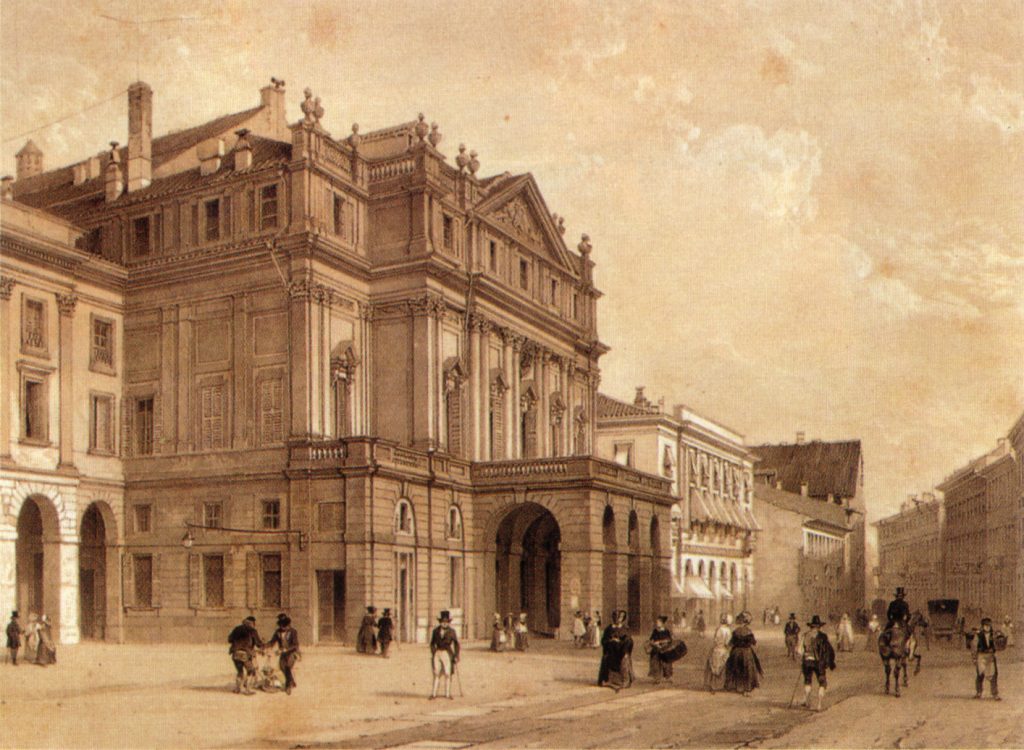
The prestigious La Scala Opera House opened in 1778 and was one of the largest in Europe with a huge stage and 3000 seats. It was a glamorous meeting place for the nobility and wealthy citizens of Milan and many flocked to see the popular ballet Il Capitano Cook all’isola degli Ottaiti.
In October 1788, the French ballet La Mort du Capitaine Cook, à son troisième voyage au nouveau monde: pantomime en quatre actes (The Death of Captain Cook on his third voyage to the new world) premiered in Paris.
 With script by Jean François Mussot Arnould and music by Jean-Baptiste Rochefort, the ballet’s four acts included fifty-eight different musical items ranging from dances and processions, to storms and battles. Although the story line was only loosely based on fact, Arnould stressed “his desire to present this ‘mort tragique’ in a manner … dignified and befitting the stature of a hero known throughout Europe”. He emphasised the efforts undertaken to replicate the costumes, manners, dances of the savages of the South Seas in an authentic manner.
With script by Jean François Mussot Arnould and music by Jean-Baptiste Rochefort, the ballet’s four acts included fifty-eight different musical items ranging from dances and processions, to storms and battles. Although the story line was only loosely based on fact, Arnould stressed “his desire to present this ‘mort tragique’ in a manner … dignified and befitting the stature of a hero known throughout Europe”. He emphasised the efforts undertaken to replicate the costumes, manners, dances of the savages of the South Seas in an authentic manner.
This French version served as the basis for the English production which was first staged in London’s Covent Garden Theatre the following year and went on to enjoy great popularity throughout Britain and America.
A German version of the historical-pantomime ballet, Cook, oder die Englander auf Otahaiti (in five acts) was invented and composed by Mr. Lauchlin Duquesney. It was performed “in the very noble La Fenice theater” in Venice for the Carnival of the 1796, and at the great Royal Theatre in Berlin during Carnival 1801. It was probably performed in many more locations however the records are limited — it seems to have very successful, being published in Berlin in 1796, 1800, and 1801. In common with the Italian choreographer Muzzarelli, Duquesney was himself a celebrated dancer. Muzzarelli was a highly acclaimed master who took the leading role in productions throughout Italy between 1771 and 1794. Little is known about Duquesney, but his fame extended to performances at the King’s Theatre in London in company with the great virtuoso Auguste Vestris.
In 1796, Leonardo Timonel published the Spanish La Cokiada : tragedia nueva en tres actos [Cook: a new tragedy in three acts]. In the preface, Leonardo wrote about the outstanding contributions of Cook to geography and nautical science — filling in the map and illustrating the world. He considered his translation and publication of the tragedy as a great service to his country and laments the inconsolable misfortune of the famous navigator’s early death, believing that Cook was a man so outstanding that the Muses should perpetuate his memory.
In 18th century Europe, James Cook was lauded as a great navigator who explored vast tracts of the world, bringing the awareness of different people and customs to humanity. The stories of his travels inspired a variety of theatrical works which gave audiences a taste of these places and people in lively and interesting ways. Both the opera and dance pantomimes remained popular throughout Europe well into the 19th century.
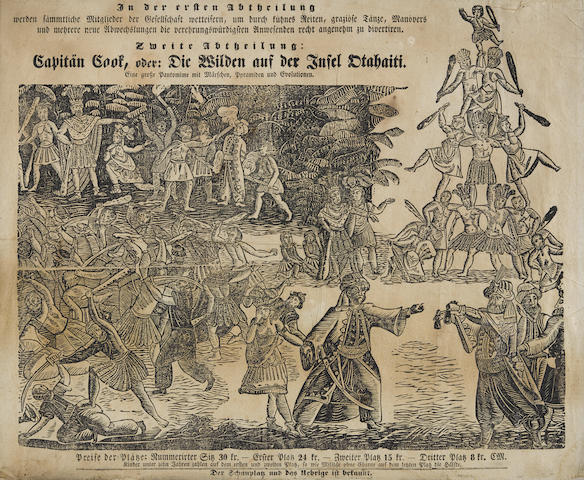
A German playbill c.1840.
Capitän Cook, oder Die Wilden auf der Insel Otahaiti, eine grosse Pantomime mit Märschen, Pyramiden und Evolutionen. (Captain Cook, or The Wild On Otaheiti Island, a great pantomime with marches, pyramids and evolutions).
In 2017 this playbill was sold by Bonhams for $10,298 (US$ 6,250).
Select bibliography
Balme, C. (2006). Pacific Performances: Theatricality and cross-cultural encounter in the South Seas: Springer.
Clarke, H. B. (2014). Captain Cook’s Country Dance. Australian Folklore, 29(November 2014), 71-86.
Denning, G. (1992). Mr Bligh’s Bad Language. Passion, power and theatre on the Bounty. Cambridge: Cambridge University Press.
Keys, A. C. (1958). Zoraï Ou Les Insulaires De La Nouvelle-Zélande. Journal of the Australasian Universities Language and Literature Association, 9(1), 36-47.
Looser, D. (2009). Remaking Pacific Pasts: A Comparative Study of Contemporary Historiographic Theatre from Oceania. https://ecommons.cornell.edu/bitstream/handle/1813/13565/Looser,%20Diana.pdf;sequence=1
Onesti, S. (2014). Dietro la traccia de’gran maestri. Prassi e poetica del ballo pantomimo italiano negli ultimi quarant’anni del Settecento. http://paduaresearch.cab.unipd.it/6332/1/onesti_stefania_tesi_1.pdf
Sabee, O. (2016). Théophile Gautier’s Ballet d’Action: Rewriting Dance History through Criticism. Dance Chronicle, 39(2), 153-173.
______________________________________________________________
This resource was created on the lands of the Gubbi Gubbi people.
We pay our respects to their elders past and present.
Sovereignty was never ceded.
______________________________________________________________
Header credits:
1. Portrait of Captain Cook by Nathaniel Dance-Holland [Public domain]
2. A jig on board by Cruikshank. Courtesy of The Lewis Walpole Library, Yale University
3. View of the South Seas by John Cleveley the Younger [Public domain]
______________________________________________________________
The information on this website www.historicaldance.au may be copied for personal use only, and must be acknowledged as from this website. It may not be reproduced for publication without prior permission from Dr Heather Blasdale Clarke.

